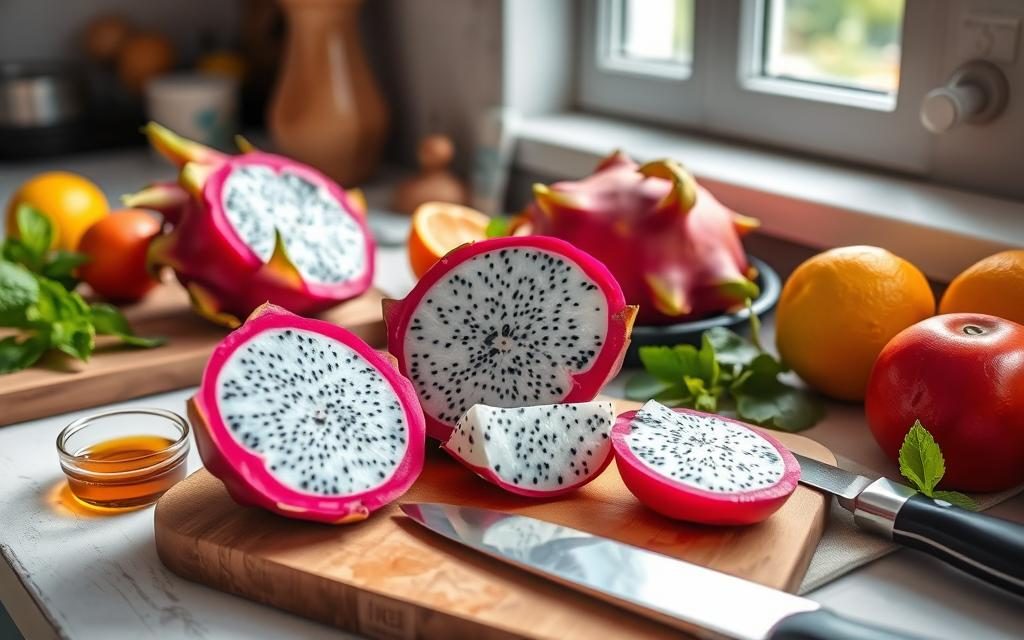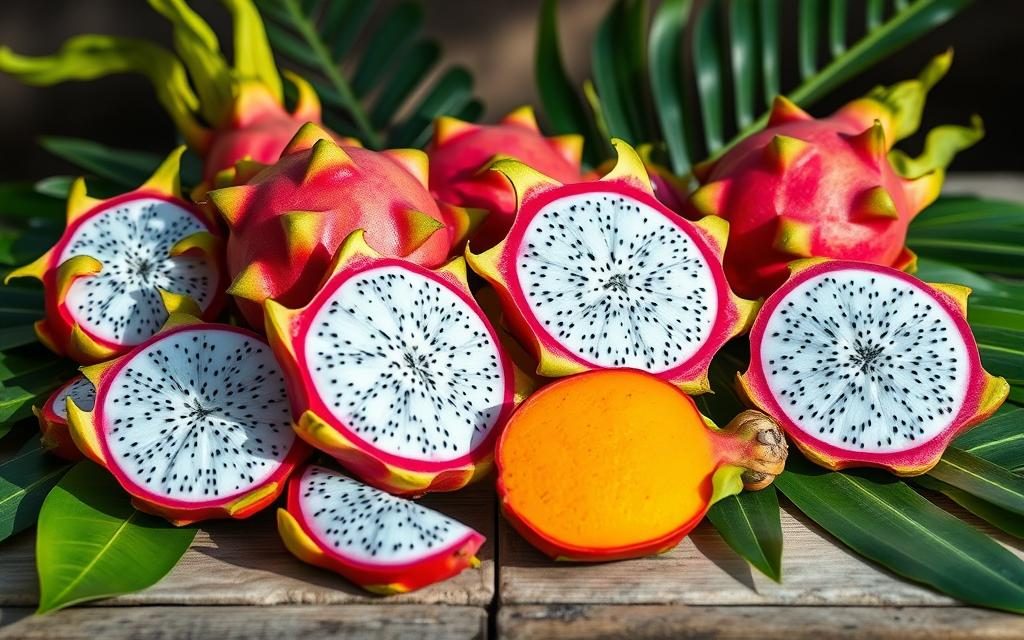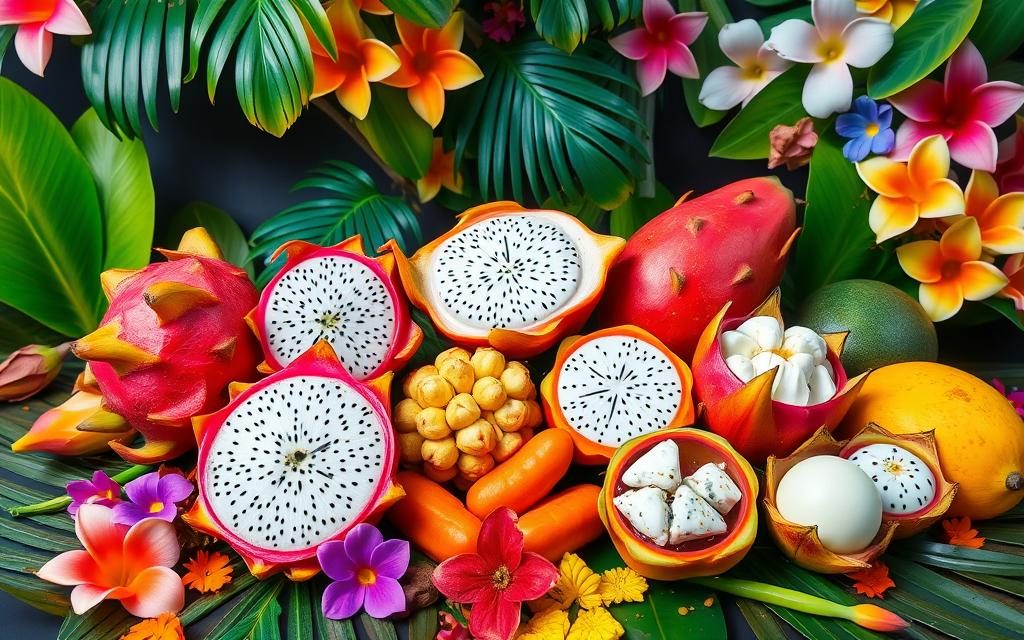Ever wondered what a tropical fruit that looks like an alien might taste like? Dragon fruit, or pitaya, is a mysterious fruit. It has a unique flavor and a stunning look.
The dragon fruit flavor is a mix of subtle sweetness and interesting texture. White dragon fruit tastes a bit like a barely ripe watermelon. Red and purple varieties are juicier and sweeter, exciting your taste buds.
This exotic fruit tastes like kiwi, pear, and has a light botanical hint. Each bite is an adventure. The texture is grainy like a ripe pear but also refreshing and watery. It’s great for hot summer days.
Key Takeaways
- Dragon fruit offers a unique, mild tropical taste
- Flavor varies between white, red, and purple varieties
- Texture combines graininess with a watery crunch
- Nutritionally rich with low calories
- Perfect for adventurous food enthusiasts
Introduction to Dragon Fruit
Dragon fruit is also known as pitahaya and strawberry pear. It’s a tasty fruit from the Hylocereus cactus. This fruit comes from Central and South America and is loved by many.
Origins and Botanical Roots
The Hylocereus cactus is where dragon fruit comes from. It starts in southern Mexico and Central America. This fruit has traveled far from its wild roots to become a favorite around the world.
- Native to tropical regions of Central America
- Cultivated in diverse locations like Vietnam, Thailand, and the Philippines
- Successfully grown in three US states: California, Florida, and Hawaii
Fascinating Name Variations
Dragon fruit has many names. Pitahaya and strawberry pear are just a few. These names show how special this fruit is to different cultures.
| Region | Common Name | Cultural Context |
|---|---|---|
| Central America | Pitaya | Indigenous terminology |
| Southeast Asia | Strawberry Pear | Descriptive culinary nickname |
| Global Markets | Dragon Fruit | Dramatic appearance-inspired name |
The fruit’s journey from a local cactus fruit to a global favorite shows its appeal. It’s loved for its taste and unique look.
The Flavor Profile of Dragon Fruit
Dragon fruit has a unique taste that excites many. It’s sweet and has a special texture. Each bite can be a new surprise because of its different flavors.
Sweetness Levels Explained
Dragon fruit can be sweet or not very sweet. Yellow dragon fruit is the sweetest. White dragon fruit is milder, like kiwi.
- Yellow dragon fruit: Sweetest variety
- Red dragon fruit: Deeper, more intense flavor
- White dragon fruit: Mildly sweet, reminiscent of kiwi
Texture: A Unique Culinary Experience
Dragon fruit is fun to eat because of its texture. It has tiny seeds that feel like kiwi. The texture can be grainy or smooth, depending on the fruit.
| Variety | Texture | Flavor Intensity |
|---|---|---|
| White Dragon Fruit | Grainy, light | Mild |
| Red Dragon Fruit | Smooth, juicy | Intense |
| Yellow Dragon Fruit | Creamy | Sweet |
Overall Taste Description
Dragon fruit tastes like a mix of pear, kiwi, and watermelon. It’s refreshing and light. This makes it great for many dishes.
Pro tip: For the best taste, pick a fruit with bright skin and a bit soft. How ripe it is affects its sweetness and flavor.
Comparing Dragon Fruit to Other Fruits
Dragon fruit is special in the world of fruits. It has a taste that is both familiar and new. This makes it exciting for people who love to try new foods.
Similarities to Kiwi and Pear
Dragon fruit tastes a lot like kiwi and pear. It has small, crunchy seeds like kiwi. These seeds add a fun crunch to each bite.
Like pears, dragon fruit is sweet but not too much. It also has a soft, grainy feel. This makes it both refreshing and tasty.
- Seed texture similar to kiwi
- Mild sweetness comparable to pear
- Soft, delicate flavor profile
Unique Differences From Other Exotics
Dragon fruit is different from fruits like mango or pineapple. It tastes milder and more subtle. This makes it perfect for those who like softer flavors.
Flavor Comparisons to Watermelon
Dragon fruit is like watermelon but less juicy. Its pale flesh is crisp and refreshing. Its subtle sweetness and light texture create a unique palate experience that sets it apart.
| Fruit | Texture | Sweetness Level |
|---|---|---|
| Dragon Fruit | Soft with crunchy seeds | Mild to moderate |
| Kiwi | Similar seed crunch | Slightly more tart |
| Watermelon | Juicy | More pronounced sweetness |
How to Choose a Ripe Dragon Fruit
Choosing the right dragon fruit is like an art. Knowing how to pick the best one makes eating it even better.
Signs of Ripeness to Look For
Here are some signs to find a ripe dragon fruit:
- Check the color intensity and evenness
- Assess the fruit’s external texture
- Gently test the fruit’s firmness
- Smell the stem end for a subtle sweetness
The Right Color: What Does It Indicate?
Dragon fruits show different colors when they’re ripe:
- Red dragon fruit: Look for vibrant pink or deep red skin
- White dragon fruit: Seek golden-yellow exterior hues
- Purple dragon fruit: Expect rich magenta or bright purple tones
- Yellow dragon fruit: Anticipate uniform bright yellow coloration
Touch and Feel: A Practical Guide
Understanding how to pick a ripe dragon fruit is key. A ripe one should:
- Yield slightly when gently pressed
- Feel heavy for its size
- Have smooth, well-defined scales
- Demonstrate a subtle give without mushiness
Stay away from fruits with brown spots, soft areas, or green patches. These signs mean the fruit is too ripe or not ripe enough. The best dragon fruit has the right color, texture, and smell.
Preparing and Serving Dragon Fruit
Dragon fruit is fun to eat and full of good stuff. It’s great for making new recipes. You can enjoy its taste and health benefits in many ways.
Fresh Consumption: Best Practices
Here’s how to eat dragon fruit right:
- Pick a fruit with bright red or pink skin
- Cut it lengthwise with a sharp knife
- Use a spoon to get the white or red inside
- Don’t eat fruit with dark spots or bruises
Creative Ways to Incorporate in Dishes
Dragon fruit makes dishes special with its texture and taste. Try these cool ideas:
- Add cubed dragon fruit to fruit salads
- Put it on top of yogurt or açai bowls
- Make dragon fruit kebabs with other fruits
- Make colorful fruit platters
Enjoying Dragon Fruit in Smoothies
Dragon fruit smoothies are tasty and healthy. Here’s how to make a great one:
| Ingredient | Quantity | Purpose |
|---|---|---|
| Dragon Fruit | 1 cup | Base |
| Yogurt | 1/2 cup | Creaminess |
| Honey | 1 tbsp | Sweetener |
| Milk/Alternative | 1/2 cup | Liquid |
For the best smoothie, use cold fruit. Add apple juice or honey for flavor. Try different milks like soy or almond.
Culinary Uses of Dragon Fruit
Dragon fruit is now used in many dishes. It adds a special flavor and color. Chefs and home cooks love it for its unique taste and look.

Unique Recipes Featuring Dragon Fruit
Creative cooks can make dragon fruit into fun dishes. Here are some ideas:
- Dragon Fruit Smoothie Bowls
- Tropical Fruit Salsa
- Colorful Grain Bowls
- Vibrant Dessert Toppings
Pairing Suggestions
Dragon fruit goes well with many flavors. It’s sweet and pairs well with other tastes.
| Fruit Pairings | Complementary Ingredients |
|---|---|
| Tropical Fruits | Mango, Pineapple, Passion Fruit |
| Citrus Fruits | Lime, Orange, Grapefruit |
| Herbs | Mint, Basil, Cilantro |
Dragon Fruit in Desserts and Salads
The fruit is great for refreshing summer desserts and salads. Add it to yogurt parfaits or fruit salads.
Culinary fans can try new things with dragon fruit. It’s perfect for making dishes look and taste amazing. Dragon fruit is a hit in cooking, inspiring new ideas.
Nutritional Benefits of Dragon Fruit
Dragon fruit is full of health benefits. It’s packed with nutrients that boost your health. This fruit is a great way to stay healthy.
The health perks of pitaya go beyond its looks. Let’s look at the amazing nutrients in dragon fruit. It’s a fruit you should eat every day.
Nutritional Breakdown
| Nutrient | Amount per 6-ounce Serving |
|---|---|
| Calories | 102 |
| Carbohydrates | 22g |
| Fiber | 5g |
| Protein | 2g |
| Vitamin C | 4.25mg |
| Magnesium | 68mg |
| Iron | 1.26mg |
Key Health Advantages
- Supports heart health with zero unhealthy saturated fats
- Boosts immune system through high vitamin C content
- Promotes digestive health with prebiotic fiber
- Helps regulate blood sugar levels
- Provides powerful antioxidant protection
Dragon fruit is a great choice for those looking for healthy food. It’s low in calories but full of nutrients. Rich in antioxidants like betacyanins and carotenoids, it may help fight cancer and keep cells healthy.
Potential Considerations
While dragon fruit is good for you, eat it in moderation. Too much can upset your stomach because of its fiber. If you have allergies, talk to a doctor before eating it.
Add dragon fruit to your diet for its taste and health benefits. It’s a tasty way to get more nutrients.
The Cultural Significance of Dragon Fruit
https://www.youtube.com/watch?v=QPhVtosE6c0
Dragon fruit is more than a fruit. It’s a part of many cultures around the world. It started in Central and South America and now is loved everywhere.
In Southeast Asia, dragon fruit means a lot. It’s not just food. It’s a symbol of tradition and culture.
Traditional Culinary Practices
People use dragon fruit in different ways:
- Vietnam uses dragon fruit in ceremonial offerings
- Thailand incorporates the fruit in traditional desserts
- Mexico celebrates the fruit during local festivals
Symbolic Meanings and Festivities
The fruit looks like a moonflower or Lady of the Night. Its flowers bloom at night. This means mystery and change in stories.
Global Cultural Exploration
There are over 100 types of dragon fruit worldwide. It connects people from California to Southeast Asia. It shows how food can bring us together.
Dragon fruit shows how food can bring people together. It inspires and connects us through food.
Popular Myths About Dragon Fruit
Dragon fruit has caught the eye of food lovers everywhere. But, many myths surround this exotic fruit. Knowing the truth about dragon fruit myths and pitaya misconceptions helps us enjoy it more.
- Myth: Dragon fruit always tastes intensely exotic
Reality: Most dragon fruits taste mild, like a mix of pear and kiwi. Their flavor is gentle, not too strong.
- Myth: All dragon fruits taste the same
Reality: Each variety has its own taste. Yellow dragon fruit is sweeter, like honey. White and red varieties have their own special flavors.
- Myth: Dragon fruit skin is inedible
Reality: The skin is safe to eat. Some chefs use it as a serving dish or in recipes.
Dispelling Pitaya Misconceptions
Knowing the truth about dragon fruit clears up common myths. Its mild taste and health benefits make it a great addition to meals.
Expert Insights into Dragon Fruit
Nutritionists and food experts say to try dragon fruit with an open mind. Its mild taste and health benefits make it a great choice for a healthy diet.
Frequently Asked Questions about Dragon Fruit
Dragon fruit is a popular fruit that many people are curious about. Our dragon fruit FAQs will tell you all you need to know about this unique fruit.

Is Dragon Fruit Good for You?
Yes, dragon fruit is very good for you! It has lots of health benefits. Here’s what you get in one cup:
- Only 103 calories
- 6 grams of fiber
- High levels of antioxidants
- Essential vitamins and minerals
This fruit boosts your immune system, helps with digestion, and can help you lose weight. It also has antioxidants that protect your cells and might lower blood sugar.
Can You Eat The Skin?
Yes, you can eat dragon fruit skin, but it tastes bitter. Culinary experts recommend using the peel in creative ways:
- Incorporating into smoothies
- Using as a natural food coloring
- Creating tea infusions
How Do You Store Dragon Fruit?
Storing dragon fruit right is important to keep it fresh. Here are some tips:
- Uncut fruit can last 1-2 weeks at room temperature
- Refrigerate ripe fruits to extend shelf life
- Store cut dragon fruit in an airtight container
- Consume within 2-3 days after cutting
- Freeze for longer preservation
When picking dragon fruit, choose fruits with bright, vibrant skin and a slightly soft texture. This way, you’ll get the best taste and experience.
Conclusion: Why You Should Try Dragon Fruit
Start an exciting exotic fruit experience. Dragon fruit will change how you see food. It’s more than just a taste.
Discovering dragon fruit is more than tasting. It’s about finding new flavors and health benefits. These can change your diet.
A Flavor Journey Worth Exploring
- Experience a mild, refreshing taste profile
- Discover versatile culinary applications
- Enjoy possible health benefits
- Expand your palate with unique texture
Nutritional Highlights of Dragon Fruit
| Nutrient | Benefit |
|---|---|
| Vitamin C | Boosts immune system |
| Antioxidants | Fights free radicals |
| Fiber | Supports digestive health |
Culinary creativity knows no bounds with dragon fruit. Use it in smoothies, salads, or eat it fresh. It’s a memorable taste.
Your culinary adventure is waiting. Explore dragon fruit and make your meals special with this tropical gem.
Further Reading on Exotic Fruits
Exploring exotic fruit resources is exciting for food lovers. It’s a journey into unique fruits. This opens up new tastes and adventures.

For those eager to learn more about tropical fruits, there are great resources. They offer deep insights into dragon fruit and other exotic fruits.
Essential Books for Fruit Enthuasiasts
- Tropical Fruits: A Complete Guide by Dr. Rafael Espinosa
- The Exotic Fruit Lover’s Handbook by Maria Rodriguez
- Cactus Fruits: From Garden to Table by James Franklin
Online Resources and Blogs to Follow
- Tropical Fruit World (a website full of exotic fruit info)
- Culinary Botanica Blog
- Global Fruit Explorer YouTube Channel
- International Tropical Agriculture Center’s Research Publications
These resources give detailed info on tropical fruits. They help you learn about growing, eating, and using unique fruits like dragon fruit.
Recommended Websites for Deeper Exploration
- Agricultural extension websites from tropical areas
- Botanical garden online archives
- Specialized fruit cultivation forums
Explore these resources to learn more about dragon fruit. Expand your knowledge of exotic fruits.
Final Thoughts
Dragon fruit is more than a tasty treat. It’s a doorway to a world of flavors from Southeast Asia and Central America. It’s a culinary adventure for food lovers in the United States.
Trying dragon fruit is more than just eating. It’s a chance to discover new tastes. You might find mild sweetness or a hint of earthiness. Each color—white, red, or yellow—brings its own flavor to the table.
Embracing New Flavors and Cultural Diversity
Dragon fruit pushes us to try new things. It’s good for you and adds excitement to meals. Its unique look and taste can start interesting conversations at dinner.
Invitation to Share Your Own Experiences
We want to hear about your dragon fruit adventures. Share your favorite recipes and stories. Your tales can inspire others to explore new fruits and flavors.




